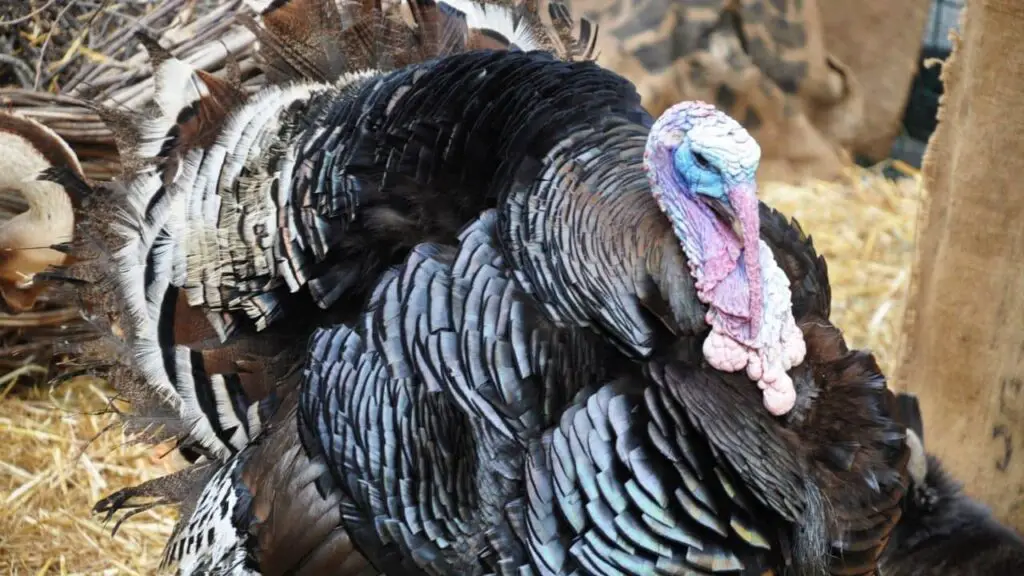Turkey in Golf: Understanding the Term and Its Origins
A “Turkey” in golf is the achievement of scoring three consecutive birdies in a single round. A birdie occurs when a player takes one less stroke than par to sink the ball. To achieve a Turkey, a golfer must maintain consistent skill and luck, scoring three under par on three consecutive holes. This term’s origin likely relates to bowling’s “three strikes” or World War II slang. It showcases a golfer’s impressive consistency and skill.

Key Takeaways
- A “Turkey” in golf signifies achieving three consecutive birdies in a single round, showcasing a golfer’s skill and consistency on the course.
- Golf scoring involves completing holes with fewer strokes than par. Understanding par, birdies (one stroke under par), and eagle opportunities are key to comprehending the concept of a turkey.
- To attain a Turkey, golfers must score three under par on three successive holes. Maintaining focus, employing strategies on par 5 holes, and staying consistent are crucial for achieving this remarkable feat.
- Legendary players like Tiger Woods, Phil Mickelson, and Ernie Els have achieved turkeys, showcasing exceptional skill and precision in the sport.
- Golf’s unique terminology and complex scoring system set it apart from other sports. The concept of a turkey, three consecutive birdies, highlights golf’s intricate challenges and strategies for success.
Introduction
Golf is a sport that has been around for many centuries, and it is loved by people from all over the world. One of the most exciting things about golf is when a player gets a turkey. But what exactly is a Turkey in golf? If you’ve been curious about this question, then you’re in the right place!
In this article, we’ll explore what turkey in golf means, how to achieve it, and famous turkeys throughout history. A turkey in golf refers to when a golfer scores three consecutive birdies during one round of golf.
To understand what this means, let’s first look at what birdies are in golf. A birdie occurs when a player hits the ball into the hole with one stroke less than par for that specific hole.
For example, if you hit the ball into the hole with two strokes on a par 3 hole (when par usually denotes three strokes), then you’ve scored a birdie. Now let’s take it up another level – consecutive birdies!
"A Turkey in golf refers to when a golfer scores three consecutive birdies during one round of golf. It's an impressive feat that showcases both skill and consistency on the course."
Enjoying this article? Read more:
This means that a player has scored two or more birdies in succession during their round of golf. Getting three consecutive birdies is considered an impressive feat because it requires both skill and luck.
To achieve a Turkey in golf, players typically need to score three under par on three consecutive holes (e.g., making an eagle on one hole and two straight birdies). Alternatively, scoring five under par across holes also achieves this feat (e.g., making an eagle on one hole and two straight pars).
A double eagle or albatross would accomplish this too! So why is getting three consecutive birdies called a turkey?
Well, some believe that this term originated from bowling, where getting three strikes in succession was referred to as “a turkey“. Others think that it was coined by American soldiers during World War II who used “turkey” as a slang term for any score of three. Regardless of its origin, getting a Turkey in golf is a highly sought-after achievement among players.
It shows that the player has the skill and consistency to score under par on multiple holes in a row. Stay tuned to learn more about famous turkeys throughout history and how to achieve this impressive feat!

What is a Turkey in Golf?
A turkey in golf is a term that refers to a set of three consecutive birdies in one round. This golf terminology is pretty popular among golf enthusiasts and is part of the lexicon of the game.
As we know, golf is a game that requires skill and strategy, where players use different clubs to hit a ball into a hole in as few strokes as possible. By understanding the basics of scoring in golf, it becomes easy to explain what a turkey means.
In golf jargon, scoring opportunities are defined by how many strokes it takes for you to complete each hole on the course. The fewer strokes you take, the better your score will be at the end of your round.
Each hole has a predetermined par value (a target score), and players aim to finish each hole under that par value. The most common type of hole in golf is a par 4, but there are also long holes known as par 5s and shorter ones called par 3s.
Now let’s bring this back to turkeys – when players manage to finish three consecutive holes under their respective pars, they earn themselves their first birdie streak, or what we call “one turkey“. Achieving three individual birdies might seem like an easy feat for professional or experienced players, but it’s not always so straightforward; every course presents its own challenges, and conditions can change quickly.
It’s worth noting that while turkeys are impressive feats for any golfer, they are not alone atop this stunning list of accomplishments on a single round at a specific golfing venue; there are other rare scores, such as albatrosses or condors, which require even more exceptional skills and luck than those required for turkeys!
Enjoying this article? Read more:

Understanding Golf Scoring
Scoring is an essential part of golf, and it’s essential to understand the different terms used when tracking your progress on the course. For enthusiasts of the sport, golf jargon can be second nature, but for others new to the game, it can take some getting used to.
In golf, a match usually consists of 18 holes of golf played at a specific golf venue. One term that comes up in golf scoring is “par.” Par refers to the number of strokes that an expert golfer is expected to make on a hole.
Each hole on a golf course has its own par value assigned based on its length and difficulty. Par values typically range from three (on short holes) to five (on long holes).
Another term you’ll encounter is “birdie.” A birdie means that you completed a hole one stroke under par. For example, if you sink your ball in four strikes on a par five hole, then you’ve scored a birdie.
Now let’s talk about “turkey.” A turkey in golf refers to hitting three consecutive birdies. This feat is not easy by any means and requires precision and focus for scoring opportunities throughout those three holes.
We have the albatross or double eagle, which means scoring three strokes under par in one hole! It’s even rarer than turkey; players might go their entire careers without ever hitting an albatross or double eagle!
Understanding this basic golf terminology will help you follow along with your scores during your matches. Keep practicing and trying for those birdies, hoping one day you can hit that elusive hat trick or, even better yet – an albatross!

How to Achieve a Turkey in Golf
To achieve a turkey in golf, a player must hit three consecutive birdies during a round of golf. In other words, it’s a rare golf achievement that involves scoring three under par on three consecutive holes. The term “turkey” is believed to have been coined in the mid-20th century when American bowlers started using it to describe three strikes in a row.
Golfers adopted the term soon after, and it has since become part of the lexicon of golf. Scoring a turkey requires skill, patience, and luck.
Even professional players find this feat difficult, as the chances for error increase with each successive hole. However, there are some strategies that can increase the likelihood of achieving this set of three birdies.
One such strategy is to play aggressively on par 5s, where players can make birdies more easily due to their length. Another way to improve your chances of achieving a turkey is to maintain your focus throughout the round and avoid getting too caught up in past or future shots.
Each shot should be treated like any other – with full concentration and commitment. Consistency is key when trying to achieve any rare golf achievement.
"The term 'Turkey' is believed to have been coined in the mid-20th century when American bowlers started using it to describe three strikes in a row. Golfers adopted the term soon after, and it has since become part of the lexicon of golf. Achieving a Turkey requires skill, patience, and luck."
Enjoying this article? Read more:
It’s also important to remember that not all tournaments or matches recognize turkey in their scorekeeping format. It’s always best to check with tournament officials or fellow players before counting on a scorecard credit for achieving this feat.
In terms of golf terminology, there are no special glossary terms associated with achieving a turkey aside from “trio of birdies.” However, there is one even rarer achievement that surpasses turkey – known as the Condor, which involves scoring four under par on one hole.
Overall, achieving a Turkey is considered an impressive accomplishment among golfers, regardless of whether it’s recognized by all matches or tournament formats, and knowing how to approach each hole strategically and consistently can help make this rare achievement attainable, albeit challenging.
Enjoying this article? Read more:

Famous Turkeys in Golf History
There have been many famous turkeys throughout golf history. A turkey is a rare golf achievement where a golfer scores three under par in a row on three consecutive holes, resulting in a score of nine under par for that set of holes. Let’s take a look at some golf legends who have achieved this remarkable feat.
- One of the most notable turkeys in golf history was achieved by Tiger Woods during the 1998 Sprint International tournament. Woods had already scored two birdies and an eagle before teeing off on the 13th hole, which he then birdied, followed by another birdie on the 14th and yet another one on the 15th hole. This trio of birdies resulted in him achieving his first career turkey.
- Another legendary player who achieved this feat is Phil Mickelson. He accomplished his first turkey during the 1996 Las Vegas Invitational championship at TPC Summerlin golf course. Mickelson played exceptionally well, scoring an eagle followed by two consecutive birdies for three consecutive holes.
- A third famous golfer who has achieved multiple turkeys throughout his career is Ernie Els. Els once made history when he scored back-to-back turkeys during the Desert Classic at PGA West in La Quinta, California. He also went on to achieve another turkey years later during the Pebble Beach Pro-Am tournament.
Achieving a turkey is not an easy task for any golfer; however, there are those who have managed to pull it off with great skill and precision over their careers. These legendary players, such as Tiger Woods, Phil Mickelson, and Ernie Els, are just some of many that will go down in history as masters of this rare and impressive golf achievement that continues to elude many aspiring professional golfers even today!

Turkey in Golf vs. Other Sports
When it comes to sports, there are few that can rival the intricacies and nuances of golf. With its unique terminology and complex scoring system, golf stands out among other popular sports. Among these intricacies is the concept of a turkey, which is three consecutive birdies in a single round.
But how does this compare with other sports? Let’s take a closer look.
Compared to team sports like basketball or football, golf is often seen as an individual sport. However, this doesn’t mean that golfers don’t compete against each other within their groups of three or four on the course.
In fact, one of the most exciting aspects of being on the green is watching your fellow golfers compete to see who can get the lowest golf score. Other individual sports like tennis or track and field have their own forms of streaks or hat-tricks, but they lack the same level of complexity found in golf terminology.
For example, while a tennis player might hit consecutive aces or a runner could win multiple races in one day at a track meet, these achievements lack the depth and variation found on different fairways and holes in a golf course. Par 5 holes are particularly imposing for many amateur players due to their length; but if you manage to score an eagle (one stroke under par) or even better, an albatross (three under par), it can be an unforgettable moment.
Even though there isn’t anything specifically called an eagle turkey or an albatross turkey in golfing community jargon, achieving these scores just before getting three straight birdies would be considered quite impressive. While every sport has its own unique achievements and records that athletes strive for; turkey scoring in golf stands alone with its intricate requirements for achievement: three consecutive birdies on different holes during one round at any type of free public/golfing venue.
Golf terminology makes this feat even more special since it requires a combination of skill and strategy on long holes. Whether you’re a seasoned golfer or just starting out, achieving a turkey is sure to be an unforgettable moment on the golf course.
Enjoying this article? Read more:

Common Misconceptions About Turkey in Golf
While turkey in golf is a rare golf achievement that many golfers aspire to achieve, there are still some common misconceptions about this term. In this section, we will take a look at some of the most popular misconceptions about turkey in golf.
- The first misconception is that turkey only refers to achieving three birdies in a row. While this is technically true, it’s not the full picture. To achieve a turkey, you must have three scores under par on consecutive holes. This means that if you get two birdies and an eagle or an albatross on three consecutive holes, you’ve still achieved a turkey.
- Another misconception is that turkeys only happen on par 5 holes. While it’s true that there are more scoring opportunities on par 5s than any other type of hole, turkeys can be achieved on any set of three consecutive holes, regardless of their pars. In fact, achieving a turkey on a par 3 course can be even more challenging than doing so on an 18-hole course with multiple par 5s.
- One of the biggest misconceptions about turkeys is that they’re impossible to achieve for the average golfer. While it’s true that turkeys are rare and difficult to achieve, they’re not impossible. With practice and consistency, any golfer can improve their game and increase their chances of achieving a turkey. Some people believe that achieving a turkey is purely luck-based and not skill-based. However, this couldn’t be further from the truth!
Achieving a turkey requires consistent shot-making skills and strategic play over the course of three consecutive holes. It takes practice and patience to truly master the game and increase your chances of achieving such a rare golf achievement.
While there may be several misconceptions about what constitutes a “turkey” in golf or how difficult it is to achieve one, the truth is that anyone can accomplish this rare feat with dedication and practice. Whether you’re a seasoned player or just starting out, understanding the intricacies of golf scoring and taking advantage of every opportunity on the golf course can greatly increase your chances of achieving a turkey, one of the most sought-after achievements in the golfers’ community.
Enjoying this article? Read more:

Conclusion
The turkey in golf is a rare and impressive achievement that requires skill, precision, and a bit of luck. It is not something that can be easily achieved, but when it does happen, it is an incredibly satisfying feeling.
Understanding golf scoring and the various definitions of golf terminology and jargon can help you appreciate the significance of such a feat. Achieving a turkey in golf requires focusing on each shot and staying mentally strong throughout the round.
It is often said that golf is played on the course but won or lost between the ears. This is especially true when it comes to scoring opportunities like a trio of birdies or, even better, a turkey.
As we explored throughout this article, there are many famous turkeys in golf history, from celebrated golfers like Tiger Woods to amateur players achieving this rare accomplishment on their local courses. While achieving a turkey may seem unattainable at first, with hard work, dedication to your game, and some good fortune, anyone can reach this goal.
While achieving a turkey in golf may seem impossible at first glance given its rarity among all other rare accomplishments like condors, albatrosses, or even double eagles, once you familiarize yourself with how it’s scored (a trio of birdies), how difficult it is to achieve (three under par) over three consecutive holes on any given course – it quickly becomes clear why so many golfers strive for it!
With persistence and determination, anything can happen. Keep practicing those long holes and fairways; who knows where your next round of golf will take you?
FAQs
What is a "Turkey" in golf?
A Turkey” in golf refers to achieving a specific accomplishment during a round of golf. It involves making three consecutive birdies on three consecutive holes.
What is a "birdie" in golf?
A birdie in golf is a score on a hole that’s one stroke under par. For example, if a hole is a par 4, getting the ball in the hole in 3 strokes results in a birdie.
How is a Turkey different from a Hat Trick in golf?
A Turkey and a Hat Trick are essentially the same thing in golf, but different terms are used. While “Turkey” is more commonly used, some people refer to it as a “Hat Trick,” borrowing the term from other sports like hockey.
Are there variations of the term "Turkey" in golf?
Yes, there are variations in different parts of the world. For instance, in Australia and New Zealand, it’s sometimes called a “Kiwi.” However, the concept remains the same: achieving three consecutive birdies.
Is a Turkey a significant achievement in golf?
Yes, achieving a Turkey is considered a notable accomplishment in golf. Making three consecutive birdies requires skill, focus, and consistency, which are all important aspects of the game.
How does making a Turkey affect a player's score?
Making a Turkey doesn’t have a direct impact on a player’s overall score for the round. However, it can boost a player’s confidence and momentum, which might positively affect their performance on the following holes.
Can a Turkey be made in any type of golf game?
Yes, a Turkey can be achieved in any type of golf game, whether it’s casual play, a friendly match, or a professional tournament. The concept of consecutive birdies remains the same across all formats.
How rare is it to achieve a Turkey in golf?
Achieving a Turkey is relatively rare due to the skill and consistency required to make three consecutive birdies. It’s considered an impressive feat even for experienced golfers.
Are there any rewards or recognitions for making a Turkey?
While there might not be specific rewards or prizes for achieving a Turkey, it’s often celebrated among fellow golfers as a notable accomplishment. Some golf clubs or communities might acknowledge the achievement in their own ways.
Are there strategies to increase the chances of making a Turkey?
Consistency in your shots, focusing on each hole individually, and maintaining a positive mindset can all contribute to increasing your chances of making a Turkey. Practicing your short game and putting skills can also help improve your birdie-making abilities.
Share this Post
Toni Benedito
Keep Reading
Follow Us
Recent Posts

How Do Pro Golfers Get Paid? The Business of Golf
Professional golfers get paid both before and after tournaments. Before a tournament, they receive appearance fees, sometimes exceeding $1 million, to attract top players. After the tournament, earnings depend on their placement, with the PGA

How Much Do Golf Players And Pros Make? You Won’t Believe It!
Professional golfers earn substantial incomes through tournament winnings, sponsorship deals, and endorsements. Top players on the PGA Tour can make millions annually, with significant earnings from prize money and lucrative brand partnerships. For example, Rory

The Shocking Cost: How Much Does It Cost to Fly with Golf Clubs?
Flying with golf clubs can be a hassle, but it’s worth it for avid golfers. Costs vary by airline, ranging from $30 to $150 per way. Southwest Airlines offers a generous policy, allowing one set

Why Do Golfers Tape Their Fingers Before Hitting the Course?
Golfers tape their fingers to prevent injuries from repetitive motions, provide support for existing injuries, and improve grip comfort. It’s a popular technique among amateurs and pros alike, offering a lightweight and effective solution compared

How Much Does a Round of Golf Cost? Are You on Par?
The cost of a round of golf varies widely based on factors like course type, location, and time of play. Public courses typically range from $30-$100 per round, while exclusive ones like Augusta National or

Hidden Fees: How Much Does It Cost To Rent a Golf Cart
Wondering how much it costs to rent a golf cart? Explore factors like location, rental duration, and cart type impacting prices. Daily rates range from $50 to $80, while weekly rentals can vary from $200
Table of Contents







